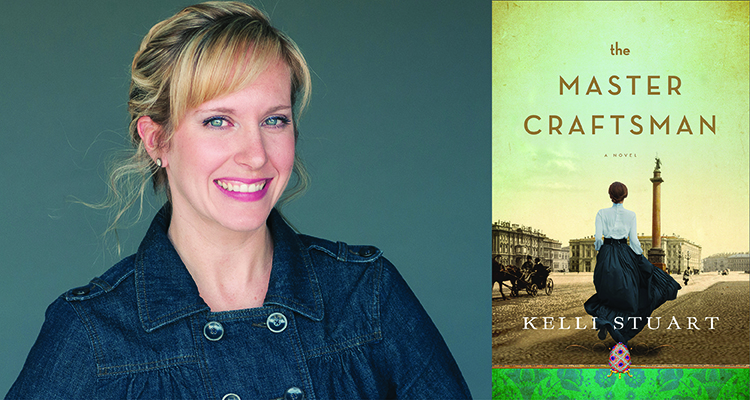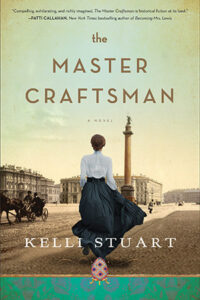Kelli Stuart is the author of the Carol Award-winning author of Like a River from Its Course, as well as A Silver Willow by the Shore and Life Creative: Inspiration for Today’s Renaissance Mom (with Wendy Speake). Stuart has written for The Huffington Post, 5 Minutes for Mom, Tonic.com, Disney, American Girl, The MOB Society, Extraordinary Mommy, God Size Dreams, Short Fiction Break, and (in)courage. Kelli is a storyteller at heart, fluent in the Russian language, and has spent the last two decades studying the Russian and Ukrainian culture.
FF: Can you please provide a brief description of your new novel, The Master Craftsman?
Two years ago, I read an article about a scrap metal dealer in the Midwest who bought a piece of art for $14,000 that he planned to melt down. Upon further inspection, however, he found that he had, not a piece of trash, but one of the missing Imperial Easter eggs that was worth $2.2 million! And that was the genesis of The Master Craftsman. Every good novel starts with a question. In this case, my question was “What if?”
What if Peter Karl Faberge designed and created an egg that he never shared with anyone else? And what if we could find it? This kicked off my own treasure hunt as I mined the history of the Fabergé Imperial Easter eggs. The Master Craftsman invites readers into this treasure hunt! Following two timelines, readers will have to connect the dots and decide for themselves—is it possible and, if so, what should we do about it?
FF: Can you offer a brief historical background on the events leading up to the Russian Revolution and the fall of the Romanovs?
It’s hard to summarize the fall of the Romanovs briefly as the history is so convoluted, but the shortest version of the story is that as the Imperial family grew more and more excessive in their wealth, the Russian people became poorer, hungrier, and more disenchanted. They wanted a leader with whom they could identify, and hidden behind palace walls and grotesque wealth, Nicholas Romanov and his family were no longer those leaders. The revolution was the people’s way of revolting, of standing up to those in power and demanding more. That’s an overly simple statement for a complex issue.
FF: A central part of this book focuses on the coveted Fabergé eggs. Can you tell us a little about these pieces and the impact they’ve had on history?
Peter Karl Fabergé came from a designer family. His father, Gustav, had been a goldsmith and a jeweler. Originally from a French Huguenot lineage, the family established themselves in St. Petersburg early on. When Peter Karl rose up to take his father’s place, he combined his business acumen with a depth of talent and vision unmatched by any of his contemporaries. This would eventually land him in front of Alexander III. In 1885, the tsar ordered a specially made egg for his wife, Marie Feodorovna. This would become a yearly tradition lasting until 1916. After Alexander III’s premature death, his son, Nicholas, would continue the tradition, adding a second egg yearly for his wife, Empress Alexandra.
The eggs themselves were fantastic pieces of art. When Alexander III and Fabergé began the tradition of gifting them to the empress, they established three rules: each egg had to look like an egg, each egg had to be unique, and each egg had to contain a surprise.
These rules left plenty of room for creativity, and Fabergé was a masterful visionary. Some of his designs were far advanced for his time, from spring mechanisms to the way that he used priceless materials to design miniature masterpieces.
He was also a masterful businessman, and he surrounded himself with the top talent. One of the things he did that separated him from his contemporaries was to hire women as master craftsmen, and one of his most talented female designers was Alma Pihl.
Alma had a unique eye for detail and, to this day, is credited with designing two of the most treasured and beloved Fabergé eggs: the Winter Egg and the Mosaic Egg.
The art and care and craftsmanship that went into the design of these eggs is astounding, and I encourage anyone who’s interested in learning more to read about them. Fabergé, for all his flaws, changed the way jewelry was made and used by the upper echelon of society. And still today, his eggs elicit awe and wonder from all who see them.
FF: This story is deeply intertwined with Russian history. What equips you to write a novel like The Master Craftsman?
I’ve long been a Soviet history buff. Ever since I first visited the former Soviet Union in 1994 as a teenager, I’ve found the culture and language fascinating. I read a lot, and most of the books I read are not the kind of books people talk about at parties. But there are treasure troves of stories to be told about the resilience, the beauty, and the courage of the people of the former Soviet Union. A lifetime isn’t enough time to tell them all.
FF: The Master Craftsman is set in dual timelines. Why did you choose these particular time frames?
I wanted to answer that what-if question. But I also wanted to tell the story of Fabergé and, even more importantly, of Alma Pihl. These were central characters in history, and they deserved to have their stories told. The best mechanism for bringing both the history and the what-if together was a dual-timeline treasure hunt.
FF: One of the main characters, Alma Pihl, is a master craftsman in the House of Fabergé. What would this role have entailed?
Alma worked her way up inside the House of Fabergé. She started as a draftsman trainee, which meant she was tasked with drawing as detailed a picture as possible of every item produced in the workshop. So keen was her eye for detail that one day she gazed out the window by her desk and she drew sketches of the ice crystals that had formed. These sketches would eventually be turned into brooches and earrings. She caught the attention of Fabergé and was promoted to master craftsman.
A master craftsman was given ownership over his or her own designs and could produce jewelry and pieces for the House of Fabergé. Alma Pihl was one of two female master craftsmen and was deeply respected inside the jewelry design community.
FF: I understand you are fluent in Russian and are very well researched in Russian and Ukrainian history. What led to your passion for learning about Russian culture?
I went on a mission trip to Minsk, Belarus, at age fifteen and instantly fell in love with the Russian language. I went to Kiev, Ukraine, at sixteen and seventeen on separate trips, and when I went to college at Baylor University, I discovered they had a Russian program, so I decided to minor in the language. I spent a semester studying in Kiev, where I lived with a Ukrainian family who shared with me their ancestor’s survival story from World War II. That story became the backbone of my first book, Like a River from Its Course. As years went on, my interest in the Russian language never waned, and I became more enthralled with the history of the former Soviet Union. It has become the mission of my life to tell the stories of the people for whom I hold such deep admiration.
FF: How will this novel appeal to both history buffs and those interested in the Romanov family as well as your average fiction reader?
It is a good blend of true history and creative fiction. The modern-day storyline is just good, fun fiction. The past timeline combines storytelling with historical facts that I tried to keep as close to reality as I possibly could without diluting the story itself.
The Master Craftsman
Kelli Stuart
Revell
Genres: Contemporary, Suspense, Romantic Suspense
Release Date: April 5, 2022
ISBN-10: 0800740424
ISBN-13: 978-0800740429
Book Summary:
In 1917, Alma Pihl, a master craftsman in the House of Fabergé, was charged to protect one of the greatest secrets in Russian history—an unknown Fabergé egg that Peter Karl Fabergé secretly created to honor his divided allegiance to both the people of Russia and the Imperial tsar’s family. When Alma and her family fled Russia amid the turmoil of the revolution in 1921, she took the secret with her, guarding her past connection to the Romanov family.
Now three generations later, Ava Laine’s estranged father—a world-renowned treasure hunter—is dying. When father and daughter are reconnected, he shares a secret with Ava that has long been hidden—a connection between her great-grandmother and a woman named Alma Pihl and a missing Fabergé egg. Her father had been searching for the egg, but with time running out, he entrusts his mission to the daughter he abandoned.
Tasked with piecing together the clues left by her late great-grandmother, Ava has no idea just how high the stakes will climb in order to find this dangerous and guarded treasure lost to history—or how her allegiances will be tested. Join the hunt in this lavish, dual-time narrative that will plunge you straight into the heart of the 1917 Russian Revolution, the fall of the famed Romanov family, and mysteries long buried in Soviet history.
Buy The Master Craftsman from the FF Store HERE!
Buy The Master Craftsman from Amazon HERE!



